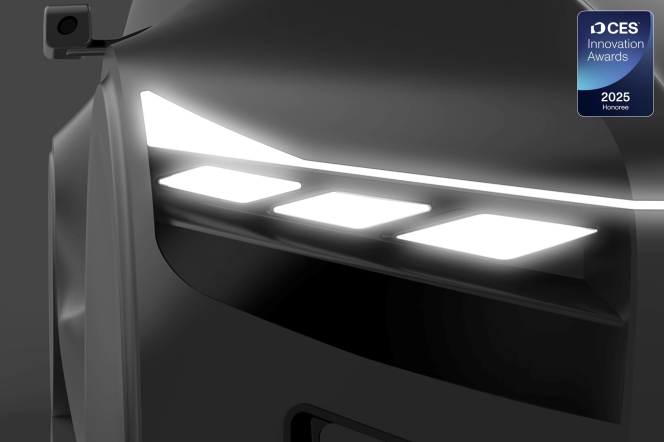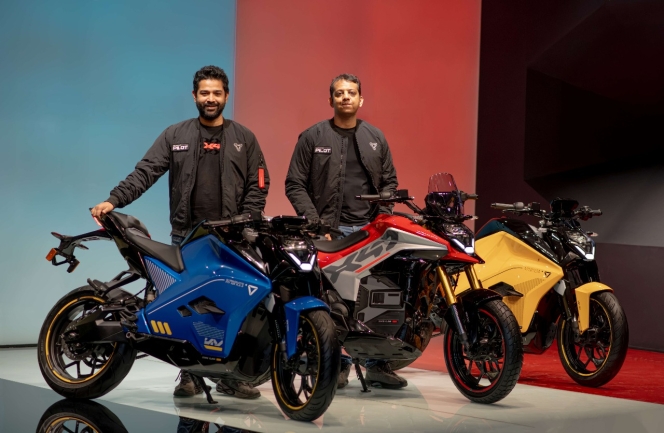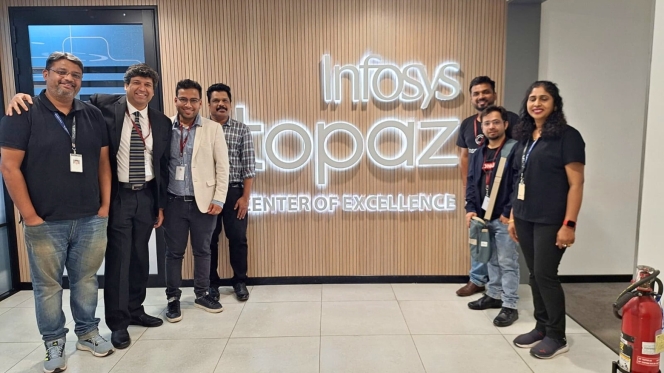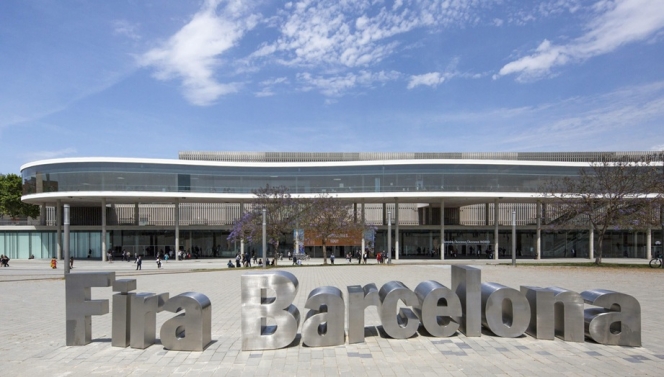- LG Innotek
- Nexlide A+
- LG Group
- vehicle lighting
- surface lighting
- Consumer Electronics Show
- CES
- CES 2025
- Consumer Technology Association
- CTA
- Moon Hyuksoo
LG Innotek’s Nexlide A+ Vehicle Lighting Module Bags CES 2025 Innovation Award
- By MT Bureau
- November 25, 2024

LG Innotek, a LG Group company focussing on automotive radar and lighting solutions among others, has been awarded the Consumer Electronics Show (CES) Innovation Award, for its vehicle lighting technology.
On 21 November 2024, LG Innotek announced that its 'Nexlide A+ automotive lighting module' received the CES 2025 Innovation Award from the Consumer Technology Association (CTA) in the United States.
The CTA recognises products and services of exhibitors that stand out for their technology, aesthetics, and innovation.
The 'Nexlide A+' is a product in LG Innotek's Nexlide series, a brand focussing on automotive lighting solutions. It is said to be the first lighting module in the industry to apply a surface light source to the front lighting module of a vehicle.
LG Innotek said that unlike typical point light sources, a surface light source emits light evenly across the entire surface. It has secured more than 700 patents related to the technology.
For a vehicle lighting module using a conventional point light source to achieve a similar effect to a surface light source, a separate component is required to spread the light from the point light source evenly, such as a light guide. In addition, the air gap, which is a layer of air required for light diffusion, needs to be thicker.
The front lighting module, due to being located at the front of the vehicle, is exposed to high temperatures and needs to be equipped with a heat dissipation structure to remove heat. This makes existing point light source products bulky, which limits design flexibility.
In comparison, the 'Nexlide A+' uses LG Innotek's unique surface light source technology to produce uniform brightness without such additional components, which also makes the module 40 percent slimmer than the existing product. This allows for efficient space utilisation and greater flexibility in vehicle design.
In addition, the company has further improved heat dissipation performance by applying high heat-resistant resin coating and film technology. The brightness has also been increased fivefold compared to conventional rear-facing lighting products, meeting the global legal standard of 500cd (candela, a unit representing the brightness of a light source) for daytime running lights (DRLs).
Till date, the company has completed more than 140 projects with domestic and foreign automotive brands and accumulated more than 150 orders. Over the past 10 years, it has recorded an average annual sales growth rate of 47 percent.
Looking ahead, LG Innotek plans to expand its lineup of rear-lighting modules to include front-lighting models. By 2025, the company also aims to develop ‘pixel lighting’ technology, which features small, three-dimensional lights arranged in a grid-like pattern. This advancement it expects to facilitate communication between vehicles(V2V) and pedestrians(V2P) enhancing safety and interaction.
Moon Hyuksoo, CEO, LG Innotek, said, "LG Innotek is solidifying its position in the global market as a total solution provider of future mobility components. With innovative products, we will grow the automotive lighting module business into a trillion-dollar industry by 2030, delivering unique value to our customers."
In January, LG Innotek will present a range of differentiated products at CES 2025, including the 'Nexlide A+' and other vehicle lighting modules as well as LiDAR (Light Detection Ranging) and sensing components for autonomous driving applications.
Neusoft And MapmyIndia Partner For Intelligent Mobility Solutions
- By MT Bureau
- December 06, 2025

Chinese technology company Neusoft Corporation and Mappls MapmyIndia have signed a Memorandum of Understanding (MoU) to leverage their strengths in software and data resources to collaborate deeply.
The companies will engage in joint technological development, ecosystem collaboration and resource integration to provide navigation products and intelligent mobility solutions tailored to localised needs in emerging markets such as Southeast Asia and India.
The partnership is a response to the fact that while global auto brands are expanding into Southeast Asia and India, they face challenges in these regions due to complex road conditions, unique traffic rules, extensive addressing systems and high localisation adaptation costs. These issues limit the ability of automakers to deliver a complete intelligent user experience.
Under the collaboration, Neusoft will adopt its OneCoreGo Global Intelligent Mobility Solution 6.0 Plus as the core technology carrier, deeply integrating MapmyIndia's map data, real-time traffic information and multi-dimensional value-added services. MapmyIndia is noted as the largest local mapping company in India, holding more than 90 percent market share in in-vehicle navigation.
The integration is intended to strengthen a full capability loop of ‘navigation + payment + interaction + connectivity + operations’.
Through API integration and technological convergence, the two parties will jointly develop navigation products and mobility solutions highly adapted to Southeast Asia, India and similar regional markets. These solutions will deliver precise route planning and real-time traffic guidance, address local user needs and continuously enhance product experience and scenario-based services. This will help automotive partners rapidly launch intelligent vehicle models with competitiveness in local markets.
The partnership enables Neusoft to combine the global end-to-end strengths of its solution with localised ecosystem resources, paving the ‘last mile’ for automakers entering the Southeast Asian and Indian markets and delivering comprehensive intelligent mobility experiences.
- Ultraviolette Automotive
- Zoho Corporation
- Lingotto
- F77
- X-47
- Shockwave
- Tesseract
- Narayan Subramaniam
- Niraj Rajmohan
Ultraviolette Secures $45 Million Growth Capital From Zoho And Lingotto
- By MT Bureau
- December 04, 2025

Bengaluru-based electric vehicle maker Ultraviolette Automotive has secured USD 45 million from Zoho Corporation and Lingotto, one of Europe's investment management companies as part of its ongoing Series E investment round.
The investment from Zoho Corporation was led by Sridhar Vembu, Mani Vembu and Kumar Vembu.
This growth capital will accelerate the domestic and international scale-up of current products F77 and X-47, as well as future product platforms Shockwave and Tesseract.
Ultraviolette has built a design and technology-led enterprise with the F77 and the recently launched X-47.
The company has expanded to 30 cities across India in a short span of 12 months and is expanding to 100 cities by mid-2026. The F77 motorcycles were recently launched in the United Kingdom, bringing Ultraviolette's presence to 12 countries across Europe.
Narayan Subramaniam, Co-Founder & CEO, Ultraviolette Automotive, said, “We are glad to announce our Series E investment from Zoho and Lingotto. Lingotto's legacy of backing iconic performance and mobility brands, combined with Zoho's long-term commitment to fostering cutting-edge Indian innovation, aligns perfectly with Ultraviolette's mission to build category-defining electric mobility solutions for India and global markets.”
Niraj Rajmohan, CTO & Co-Founder, Ultraviolette, said, "With the ongoing Series E investments, we are doubling down on growth and expanding our production to meet increasing demand. Our focus is on advancing breakthrough battery technology, elevating performance capabilities and expanding production to support upcoming product platforms. This investment will accelerate our journey towards scaling into India and global markets."
Disseqt AI Partners Tata Technologies And Infosys For Agentic AI Adoption
- By MT Bureau
- December 04, 2025

Agentic AI platform Disseqt AI has announced a partnership with Tata Technologies and Infosys. As per the agreement, Disseqt AI will assist both companies' IT and DevOps teams in developing and fast-tracking the production of tailored Agentic AI applications for automobile and FinTech companies globally.
The partnership aims to help auto and FinTech firms embrace customised Agentic AI faster and in a secure manner.
Disseqt AI, which has operations in Bengaluru, San Francisco and Dublin, provides an enterprise-grade platform for IT and DevOps teams. The company claims its platform cuts down Agentic AI testing and operations cost by 70 percent and improves productivity by up to 80 percent. The platform allows these teams to test, simulate and monitor their Agentic AI systems tailored across industries, ultimately enabling enterprises to operationalise tailored Agentic AI faster and at scale, without sacrificing ethics, governance and compliance.
Apoorva Kumar, Founder and CEO, Disseqt AI, said, “This is a landmark announcement for us as we further embed Disseqt into enterprise workflows for testing, simulation, monitoring and auditability purposes. We are already working closely with both Tata and Infosys on several projects and are proud to be part of their innovation initiatives”
Last month, Disseqt AI announced a strategic collaboration with HCLTech and Microsoft to guide financial services institutions with Agentic AI adoption.
Battery Passport Implementation Beyond EVs To Be Focus Of Barcelona Event
- By MT Bureau
- December 03, 2025

Battery and Energy Storage Europe has announced a programme focused on the EU Battery Passport, a regulatory milestone that becomes mandatory in February 2027. The Barcelona-based event will address the compliance gap for applications beyond the electric vehicle (EV) sector, which have dominated the conversation to date.
The event, taking place on 8th and 9th September 2026 at Fira de Barcelona's Gran Via venue, will focus on solutions and talks for applications that fall within the regulation's scope: stationary energy storage, industrial batteries, grid-scale systems, long-duration energy storage and emerging applications in aerospace, maritime and rail electrification.
With the February 2027 legal requirement date approaching, the programme will bring together industry leaders, technology providers, and policy experts to address the compliance challenges facing these diverse sectors.
The Battery Passport is a digital record documenting a battery's entire lifecycle, from raw material sourcing to production, performance and eventual recycling. From February 2027, it becomes mandatory for all rechargeable EV, industrial and LMT batteries over 2 kWh sold in the EU.
Linked via QR code, the passport will track each battery's complete lifecycle, including composition, carbon footprint and recycled content, fundamentally transforming supply chain transparency and sustainability practices across Europe.
The programme will explore implementation topics including digital infrastructure requirements, data management systems, supply chain integration, verification processes and recycling traceability.
Ken Davies, Conference Programme Director at Battery and Energy Storage Europe, said, "The Battery Passport represents one of the most significant regulatory shifts our industry has faced, yet many companies are still grappling with what implementation actually means for their operations. While the EV sector has dominated the conversation, there's a critical need to address how this regulation applies to stationary storage, industrial applications and the innovative battery technologies powering Europe's energy transition. With the clock ticking toward February 2027, Battery and Energy Storage Europe will shine a light on the practical implementation requirements for these often-overlooked sectors, connecting stakeholders with actionable solutions and bringing together the expertise, technology providers, and collaborative spirit needed to turn compliance into competitive advantage across the full spectrum of battery applications."






Comments (0)
ADD COMMENT